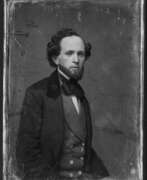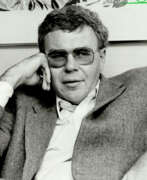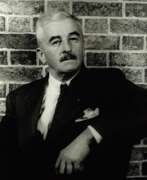Poets 20th century


Arthur Adamov, born Arthur Adamian, is a French novelist and playwright, translator of Armenian origin.
Adamov was close to the Surrealists and was friends with Artaud and Giacometti. He wrote poetry and published the surrealist magazine "The Gap". In 1938 he had a nervous breakdown. In 1941 he was arrested for his hostile statements against the Vichy government, and was held in a camp in Argeles until the end of the war.
After the war, in a state of extreme depression, he began to write confessional prose and turned to drama.


Hans Henning Otto Harry Baron von Voigt, best known by his nickname Alastair, was a German artist, composer, dancer, mime, poet, singer and translator. He is best known as an illustrator.
His drawings, which are often decadent in spirit and have the look of Art Nouveau, are influenced somewhat by the drawings of the English artist Aubrey Beardsley.
His drawings were in black and white ink, sometimes with one colour added. Alastair's illustrations show a strong influence from the Decadent movement in art and poetry that had begun decades earlier, with the "perverse and sinister" a recurring theme. Intricate decorative elements and fine detail are apparent in his works.


Josef Albers was a German-born artist and educator. The first living artist to be given a solo shows at MoMA and at the Metropolitan Museum of Art in New York, he taught at the Bauhaus and Black Mountain College, headed Yale University's department of design, and is considered one of the most influential teachers of the visual arts in the twentieth century.
As an artist, Albers worked in several disciplines, including photography, typography, murals and printmaking. He is best known for his work as an abstract painter and a theorist. His book Interaction of Color was published in 1963.


Guillaume Apollinaire, real name Wilhelm Albert Vladimir Apollinaris de Wąż-Kostrowicki, a French poet of Polish descent, was a towering figure in the early 20th century's literary and art scenes. Known for his experimental verse and support of avant-garde art movements like Cubism and Surrealism, Apollinaire's work pushed the boundaries of traditional aesthetics and inspired a generation of artists and writers.
Guillaume Apollinaire's literary contributions were vast and varied. He was an early advocate for Cubism, a relationship most prominently seen in his collaborations with artists like Pablo Picasso. He not only wrote about art but also collected it, surrounding himself with works by modernist masters such as Henri Rousseau and Georges Braque. His Paris apartment was a small museum of modern art, filled with pieces he often sold to support his literary endeavors. This vibrant artistic environment fueled his creativity, leading to major works such as Alcools and Calligrammes, which explored the possibilities of poetic form and typography to represent visual and verbal content in a unified way.
Despite his innovative work in poetry and art criticism, Guillaume Apollinaire's life was marked by personal challenges, including a grievous injury during World War I. Yet, even these difficulties did not hinder his prolific output. Among his notable works during this period was the play Les Mamelles de Tirésias, which was performed in 1917 and is considered a precursor to theatrical Surrealism.
Apollinaire's influence extended beyond his lifetime, particularly through his mentoring of future Surrealist leaders like André Breton. His forward-thinking approach to art and literature made him a central figure in the transition from traditional to modernist forms in both fields.
For collectors and experts in art and antiques, Guillaume Apollinaire's work represents a nexus of literary brilliance and pivotal artistic movements. His life and work provide fascinating insights into the dynamic and transformative world of early 20th-century art and literature.
Sign up for updates on auctions and sales events featuring items related to Guillaume Apollinaire. Stay informed about opportunities to acquire unique artifacts that celebrate his legacy in the realms of poetry and art.


Jean Arp, born Hans Peter Wilhelm Arp, was a German and French poet, painter, graphic artist and sculptor. one of the founders of the Dada movement in Zurich.
Arp used abstract forms in his work and experimented with different materials such as wood, metal and stone. He was also known for his poetic works, in which he applied a method of randomly selecting words, called the "clutter method". Arp believed that this method helped him express his thoughts more precisely and originally. Arp's influence on the arts is still significant today.


Sabine Baring-Gould was a Victorian British clergyman, poet, writer and folklorist.
He traveled extensively in Europe, studied at Clare College, Cambridge, was ordained in the Church of England in 1864, and was appointed vicar at Horbury. Baring-Gould was a polyglot and knew six languages. Despite his ministry, he had a serious interest in supernatural phenomena and in 1865 published a book called The Book of Werewolves.
In addition to this, Baring-Gould was interested in a wide range of subjects. His work is diverse and covered theology, history, poetry, hymns, fiction, biography, travel, social commentary, and folklore. Baring-Gould collected the folk songs of old English singers, personally visiting them and recording the words and music. In 1889 he published a collection of Songs of the West in four parts, of which he was proud, and also wrote several patriotic hymns.
Baring-Gould was a very prolific writer: during his life he wrote many novels, published short stories in periodicals, the popular "Curious Myths of the Middle Ages," and others, his bibliography numbering some 1,250 works.


Issa Abasovich Barkhanoyev (Russian: Исса Абасович Барханоев) was a Soviet and Russian Ingush artist of the last quarter of the twentieth and early twenty-first centuries. He is known as a painter, draughtsman, landscape painter, genre painter and poet, a self-taught artist.
Issa Barkhanoyev created more than 500 paintings during his career, in which, according to critics, he skillfully conveyed his deep thoughts and feelings through images and symbols, and these works of art epitomize spirituality and life philosophy. The works of the folk artist are in museums of the Republic of Ingushetia and private collections.


Johannes Robert Becher was a German politician, poet, and novelist.
As a young man he was part of the literary avant-garde, writing in the style of Expressionism. As a communist, Becher was evacuated from the Nazi regime to the USSR during World War II, then returned to Germany, where he was among the founders of the GDR Academy of Arts in Berlin and was its president. He was also Minister of Culture of the German Democratic Republic from 1954 to 1958.
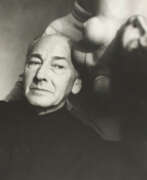

Hans Bellmer was a German graphic artist, sculptor, photographic artist, illustrator, and writer who spent most of his life in France.
In the 1930s Bellmer began working on the eroticized image of the deformed doll, contrasting it with the aesthetics of the "classical" body in Hitler's Germany. His graphic and literary explorations focus on the dismemberment and liberation of bodies. Bellmer's surrealist works are violent and provocative: they include puppet sculptures composed of the bodies of nude models, photographs, and prints.
In 1934, 18 photographs of dolls were published in the Parisian surrealist magazine Minotaur, and the Nazi regime declared Bellmer's art degenerate. In 1938, Bellmer emigrated to France.
After the end of the war, the artist continued his work, adding poetry to painting. He also authored illustrations for many works, particularly on erotic themes.


Mirella Bentivoglio is an Italian painter, sculptor and poet, representative of visual concrete poetry.
She was trained as an art historian and artist in Italy, Switzerland and England, and in the 1960s she joined the concrete poetry movement and began to use elements of the alphabet to create expressive images. A few years later, Bentivoglio became increasingly interested in sculpture, turning letters into three-dimensional forms. In many of her later works, two images, a book and an egg, began to recur.


Gastone Biggi was an Italian painter, sculptor, writer, poet, and musicologist.
Biggi combined painting with his activities as an art writer and musicologist. In 1962 his key work The Birth of the Point was published, theorizing the study of the sign module, which he would develop throughout his life. That same year he formed Group 1.
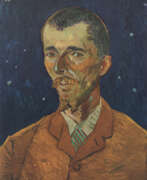

Eugène Boch was a Belgian painter, celebrated for his vibrant contributions to the Post-Impressionist movement. Boch was part of a prominent family known for their fine china business, Villeroy & Boch. He pursued his passion for art in Paris, studying under notable teachers such as Léon Bonnat and Fernand Cormon.
Eugène Boch's artistry is marked by his distinct style and use of color, which earned him spots in prestigious exhibitions like the Salon in Paris during the 1880s. His works, characterized by their emotional depth and innovative techniques, reflect the bold spirit of the Post-Impressionist era. He was not only a painter but also a visionary, whose works resonated with the aesthetic shifts of his time.
One of Eugène Boch's most notable associations was with Vincent van Gogh, who painted Boch in the famous portrait "The Poet," which Van Gogh described as a vision of idealistic and artistic purity. This painting is now housed at the Musée d'Orsay, symbolizing their profound connection and mutual respect. Boch's own works, like "The Red Roofs," demonstrate his unique ability to blend reality with his visionary outlook, showcasing scenes filled with vivid colors and dynamic compositions.
Eugène Boch's legacy extends beyond his paintings. Upon his death in 1941, he left a significant impact on the cultural heritage of Europe, influencing future generations of artists. His works continue to be celebrated in major museums and galleries, reminding us of his pivotal role in the development of modern art.
For collectors and experts in art and antiques, Boch's works offer a timeless exploration of Post-Impressionist vibrancy. Sign up for updates and stay informed about new sales and auction events featuring Eugène Boch’s timeless works, ensuring you never miss an opportunity to own a piece of art history.


Kseniya Leonidovna Boguslavskaya (Russian: Ксения Леонидовна Богуславская) was a twentieth-century Russian artist who lived and worked in Germany and France for most of her career. She is known as a painter, graphic artist, theatrical artist and designer, and poetess.
Kseniya Boguslavskaya was a representative of the avant-garde school. She created semi-abstract cubo-futuristic compositions, including landscapes, still lifes, genre scenes, and images of interiors. In the same style, the artist drew sketches for articles of applied art. She also illustrated covers of publications and worked as a scenographer.


Erwin Bovin is a German painter and poet. He received his first art education at the School of Applied Arts in Neuchâtel under the direction of William Racine. He took part in the First World War as an interpreter. During this time, he created, among other things, drawings and watercolors depicting the front in the Argonne forest. After the war, he continued to study and worked as an art teacher. In 1932-1942 he lived as a freelance artist. After leaving his position as a teacher, he went to Amsterdam to visit the Rembrandt exhibition there, and then stayed to live in the Netherlands. In addition to landscapes, Bovin painted numerous portraits and family paintings for wealthy Dutch people.


André Breton was a French writer, poet, and anti-fascist, renowned as the principal founder and leading theorist of Surrealism, an influential movement that sought to release the creative potential of the unconscious mind. Born in Tinchebray, France, in 1896, Breton's work was deeply influenced by the theories of Sigmund Freud and was characterized by a fascination with dreams, the irrational, and the workings of the mind. As a cultural icon, his contributions extended beyond literature into the realms of art, sculpture, and painting, making him a pivotal figure in 20th-century artistic movements.
Breton's seminal work, the "Manifesto of Surrealism" (1924), outlined the principles of the movement, advocating for the expression of the subconscious and the importance of dreams as a source of artistic inspiration. His leadership and writings not only shaped Surrealism but also had a lasting impact on the broader culture of art, influencing countless artists, painters, and sculptors. Breton's ability to merge poetry with visual arts led to collaborations with prominent artists like Salvador Dalí, Max Ernst, and Joan Miró, further cementing his legacy as a central figure in modern art.
Notably, André Breton's works and personal collection, which included art pieces and surreal objects, have been displayed in museums and galleries worldwide, showcasing his eclectic taste and profound influence on the art world. His Paris apartment was a gathering place for artists and intellectuals, becoming a hub of Surrealist activity and thought. For collectors and experts in art and antiques, Breton's contributions represent a fascinating intersection of literary prowess and visual creativity, highlighting the enduring relevance of Surrealism.
For those interested in exploring the depths of Surrealism and André Breton's groundbreaking contributions, signing up for updates can provide exclusive access to new product sales and auction events related to this pivotal artist and thinker. This subscription is an invaluable resource for collectors and enthusiasts keen to deepen their understanding of Breton's influence and the broader cultural movements he shaped.
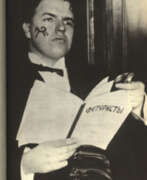

David Davidovich Burliuk (Russian: Давид Давидович Бурлюк), a pioneering figure of the Russian Futurist movement, was a Ukrainian poet, artist, and publicist, born in 1882 in Semirotovshchina, Kharkov, Ukraine, and died in 1967 on Long Island, N.Y., U.S. Known for his eclectic contributions that spanned poetry, painting, criticism, and publishing, Burliuk's work was instrumental in introducing the Russian avant-garde to Europe and the United States. Despite having a lesser volume of work in poetry and painting compared to his contemporaries, Burliuk's knack for discovering talent and promoting it was unparalleled. He was among the first to publish the works of Velimir Khlebnikov and to recognize the genius of Vladimir Mayakovsky, significantly contributing to their renown.
Burliuk's artistic journey was marked by his involvement with the Futurist and Neo-Primitivist movements. His early work, including an exhibition with the group Zveno ("The Link") in Kiev in 1908 and his participation in the Hylaea group, set the stage for his later achievements. He was a co-author of the influential Futurist manifesto "A Slap in the Face of Public Taste" in 1912, advocating for a break from traditional art forms and the embrace of modernity. Burliuk's commitment to Futurism was evident in his publishing endeavors and his collaborations with notable artists of the time.
In his later years, after emigrating to the United States in 1922, Burliuk continued to engage with the art world, contributing to pro-Soviet groups and publishing his works and those of his contemporaries. His efforts were recognized in several exhibitions, including a significant show at the Brooklyn Museum's 1926 International Exhibition of Modern Art. Despite facing challenges, such as being denied permission to visit his homeland by the Soviet government, Burliuk's influence remained steadfast. His legacy as a central figure in Russian Futurism and his contributions to the broader art movement are celebrated to this day.
To stay informed about updates and events related to David Davidovich Burliuk, including sales of his works and auction events, sign up for our newsletter. This subscription will ensure you're the first to know about new discoveries and opportunities to engage with Burliuk's enduring legacy.


Vladimir Davydovych Burliuk (Russian: Владимир Давидович Бурлюк) was a Ukrainian avant-garde artist, known for his contributions as a Neo-Primitivist and Cubo-Futurist. Born on March 27, 1886, in the Russian Empire, Burliuk's work spanned various mediums, including painting and book illustration. His art is celebrated for its bold experimentation and pioneering spirit in the early 20th century avant-garde movement. Burliuk's life was tragically cut short when he died at the age of 32 during World War I in 1917.
Burliuk's artistic output is characterized by its innovative approach and his involvement in the avant-garde circles that radically transformed Russian art. His works were part of significant avant-garde exhibitions and movements, showcasing his commitment to pushing the boundaries of traditional art. Among his notable works are contributions to publications and exhibitions that captured the essence of the avant-garde, such as "Sadok Sudei (A Trap for Judges)" in 1910 and "Moloko kobylits (Milk of Mares)" in 1914. His art is recognized for its unique body of works, blending Cubism, Rayonism, and elements of Futurism, marked by stylistic unity and high valuation by connoisseurs.
Burliuk's legacy extends beyond his own creations; his involvement with key figures and movements of the time, including his brother David Burliuk, further emphasizes his role in shaping modern art. Despite his early death, Vladimir Burliuk's work remains a testament to the vibrancy and dynamism of the avant-garde movement, with his pieces held in high regard by collectors and experts alike.
For those interested in exploring the depths of avant-garde art, Burliuk's oeuvre offers a fascinating glimpse into the revolutionary spirit of early 20th-century artistic exploration. His contributions continue to inspire and intrigue art lovers, underscoring the lasting impact of his brief but impactful career.
Sign up for updates to stay informed about new product sales and auction events related to Vladimir Davydovych Burliuk, and immerse yourself in the world of avant-garde artistry that continues to resonate with collectors and art enthusiasts alike.


Heinrich Christian Wilhelm Busch was a German humorist, poet, illustrator, and painter. He published wildly innovative illustrated tales that remain influential to this day.
Busch drew on the tropes of folk humour as well as a profound knowledge of German literature and art to satirize contemporary life, any kind of piety, Catholicism, Philistinism, religious morality, bigotry, and moral uplift.
His mastery of drawing and verse became deeply influential for future generations of comic artists and vernacular poets. Among many notable influences, The Katzenjammer Kids was inspired by Busch's Max and Moritz. Today, the Wilhelm Busch Prize and the Wilhelm Busch Museum help maintain his legacy. The 175th anniversary of his birth in 2007 was celebrated throughout Germany. Busch remains one of the most influential poets and artists in Western Europe.


Michel Butor was a French writer and poet, associated with the Nouveau Roman literary movement of the 1950s and 1960s. He was known for his experimental writing style, which often challenged traditional narrative structures and explored the relationship between language, identity, and memory.
Butor studied philosophy and literature at the Sorbonne in Paris. In 1954, he published his first novel, "Passage de Milan," which established his reputation as a leading figure of the Nouveau Roman movement.
Throughout his career, Butor wrote more than twenty novels, as well as essays, poetry, and other works. His writing often incorporated elements of travelogue and autobiography, and he frequently collaborated with visual artists on projects that combined text and image.
In addition to his literary work, Butor was a respected teacher and critic, and he lectured at universities around the world. He was awarded numerous honors and awards for his contributions to French literature, including the Prix Renaudot in 1957.
His legacy as an innovative and influential writer continues to be celebrated by literary scholars and readers around the world.
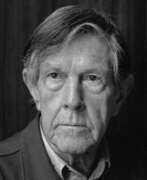

John Milton Cage Jr. is an American composer, philosopher, poet, musicologist, and artist. Cage is considered one of the leading figures of the post-war avant-garde.
Born in the United States, he studied architecture in Europe, but music and painting seemed more interesting to him and he has achieved impressive success there. John Cage is considered a pioneer of uncertainty in music and the unconventional use of instruments, and is highly regarded for his paintings and prints. In addition, he played a crucial role in the development of modern dance and performance art.
His father John Milton Cage (1886-1964) was an inventor.


Marc Chagall (Russian: Марк Заха́рович Шага́л), born Moishe Shagal in 1887 near Vitebsk, Belarus (then part of the Russian Empire), was a Belarusian and French artist celebrated for his pivotal role in the avant-garde movement and his unique integration of Eastern European Jewish culture into modern art. His contributions spanned several artistic formats including painting, stained glass, stage sets, ceramics, tapestries, and fine art prints. Chagall's early modernist tendencies were enriched by his experiences across Saint Petersburg, Paris, and Berlin before World War I, leading to a distinctive style that melded Cubism, Symbolism, and Fauvism with his Jewish heritage.
Chagall's work is recognized for its emotional depth, often exploring themes of love, memory, and Jewish folklore through vibrant colors and dreamlike imagery. Notably, art critic Robert Hughes described him as "the quintessential Jewish artist of the twentieth century," a sentiment echoed by art historian Michael J. Lewis who regarded Chagall as a significant figure within European modernism and as the world's preeminent Jewish artist of his time.
Among Chagall's famed contributions are his stained-glass windows for the cathedrals of Reims and Metz, the UN, and the Jerusalem Windows in Israel. His monumental paintings include parts of the ceiling of the Paris Opéra and works that explore biblical themes, a hallmark of his oeuvre that underscores his enduring engagement with spiritual and religious motifs.
For art collectors and antiques experts, Chagall's works are notable not only for their artistic innovation but also for their rich cultural and historical significance. His art is housed in many prestigious museums worldwide, including the Marc Chagall National Museum in Nice, France, which focuses on his works inspired by religion and houses the series of paintings illustrating the biblical message.
For those interested in exploring Chagall's legacy and the vibrant intersection of culture, art, and history his work represents, signing up for updates on new product sales and auction events related to Marc Chagall can provide invaluable insights and opportunities. This is an invitation to engage more deeply with the world of art and culture that Chagall so uniquely encapsulated in his work.


Jean Maurice Eugène Clément Cocteau was a French poet, playwright, novelist, designer, filmmaker, visual artist and critic. He was one of the foremost creatives of the surrealist, avant-garde, and Dadaist movements; and one of the most influential figures in early 20th-century art as a whole. The National Observer suggested that, “of the artistic generation whose daring gave birth to Twentieth Century Art, Cocteau came closest to being a Renaissance man.”


Heinrich Danioth was a Swiss painter and poet.
Some of Danioth’s most notable works include the murals, "Tellsprung" and "Rütlischwur", on the walls of the Tellspielhaus, an Altdorf theatre, in 1927.
He painted the mural “Fundamentum” in 1936. It is currently located at the Federal Letter Museum, one of three historical museums in Schwyz, Switzerland.
Another notable work is the large-format mural "Föhnwacht", created on behalf of the Federal Art Commission.


Antoine Marie Jean-Baptiste Roger, Comte de Saint-Exupéry, known as Antoine de Saint-Exupéry, is a French national treasure who seamlessly combined his profession as an aviator with his literary genius. Known for "The Little Prince," he masterfully blended philosophy and poetic discourse into narrative forms. This author, journalist, and pioneering pilot left an indelible mark through his literary works and contributions to aviation.
Saint-Exupéry's merits transcend his inventive storytelling; his narratives often reflect his aviation experiences, offering unique insights into humanity and technology's intersection. His works, though not housed as traditional art in museums, reside in the Louvre of public imagination and literary canon.
For enthusiasts and experts, Saint-Exupéry's legacy is a testament to the enduring power of human spirit and curiosity. His narrative sculptures crafted from words, deeply philosophical and yet whimsically accessible, continue to inspire and resonate. Dive into the world of this exceptional storyteller and aviator to explore the skies of human experience.


Fortunato Depero was an Italian futurist painter, designer, sculptor and poet. In 1913 Depero comes to Rome, where he meets the futurists Giacomo Balla and Umberto Boccioni.
In the early 1920s, Fortunato Depero tries his hand as an artist in commercial advertising, designs theatrical costumes, works for magazines and as a room decorator, and participates in many art exhibitions.


Pavlos Dionyssopoulos was a Greek artist born in Filiatra, Greece in 1930 and passed away in 2019. He was known for his unique and colorful abstract paintings, which were influenced by the art movements of the 20th century, including surrealism and abstract expressionism.
Dionyssopoulos studied art in Greece and later in France, where he was exposed to the works of famous artists such as Pablo Picasso and Henri Matisse. His style evolved throughout his career, starting with realistic portraits and landscapes before moving towards abstract art.
He held numerous solo and group exhibitions in Greece and internationally, including in Paris, New York, and Tokyo. His works can be found in private collections and museums around the world.
Dionyssopoulos was a member of the Greek Chamber of Fine Arts and was awarded the "Order of the Phoenix" by the Greek government for his contributions to the arts. He was also a writer and poet, and his poetry was published in several Greek literary journals.
Today, Pavlos Dionyssopoulos is considered one of the most important Greek artists of the 20th century, known for his unique style and contributions to the development of abstract art in Greece.


Jimmie Durham was an American sculptor, essayist and poet. He was active in the United States in the civil rights movements of African Americans and Native Americans in the 1960s and 1970s, serving on the central council of the American Indian Movement (AIM). He returned to working at art while living in New York City. His work has been extensively exhibited. Durham also received the Günther-Peill-Preis (2003), the Foundation for Contemporary Arts Robert Rauschenberg Award (2017), and the 58th Venice Biennale's Golden Lion for lifetime achievement (2019).


Marc Eemans was a Belgian painter, poet and art historian, one of the pioneers of constructivist abstraction.
In 1925, Eemans joined the Surrealist artists Dali and Magritte, with whom he held joint exhibitions. And soon the poet's fame eclipsed his success as a painter. In 1930, Eemans made his debut as a poet in Vergeten te worden: 10 lijnvormen, beïnvloed Door 10 woordvormen. Influenced by Symbolism, he calls his poetry "gnostic surrealism". In 1938 he publishes a collection of poems, Visioen Woli, and others.
His artistic and political stance during World War II led to a break with Magritte and others.
In addition to poetry collections, Eemans wrote essays on a variety of subjects, including modern painting and architecture.


Max Ernst was a pivotal figure in the 20th-century art world, whose work transcended the boundaries of nationality and genre to leave an indelible mark on culture, art, sculpture, and painting. Born in Germany on April 2, 1891, and later becoming a naturalized American and French citizen, Ernst's career was a testament to his relentless innovation and creativity. Known primarily as an artist and painter, Ernst was a founding member of the Dada movement in Cologne before becoming a major proponent of Surrealism in Paris. His early encounters with the works of Pablo Picasso, Vincent van Gogh, and Paul Gauguin at the Sonderbund exhibition in 1912 deeply influenced his artistic direction, infusing it with elements of Cubism and Expressionism. Despite his lack of formal artistic training, Ernst's experimentation with techniques such as collage and frottage showcased his unique ability to blend the absurd with the sublime, making him a central figure in the artistic avant-garde of his time.
Ernst's work is notable for its exploration of the unconscious, using dreamlike imagery and symbolic figures to critique societal norms and delve into the chaos of the human psyche. His experiences in World War I profoundly impacted his worldview, leading to a deep skepticism of Western culture and an enduring search for meaning through art. This is evident in works such as "Europe After the Rain II," which reflects the devastation of war and "The Fireside Angel," inspired by the political turmoil of the Spanish Civil War, showcasing his ability to address contemporary issues through a surreal lens.
Ernst's contributions to art are preserved in major museums and galleries worldwide, including the Tate in the United Kingdom and the Museum of Modern Art in New York. His sculptures, paintings, and collages continue to be celebrated for their innovative techniques and imaginative scope, marking him as a revolutionary figure in modern art. Among his most significant works are "Ubu Imperator," "The Elephant Celebes," and "The Virgin Spanking the Christ Child before Three Witnesses," each reflecting his mastery over a diversity of mediums and themes.
For collectors and experts in art and antiques, Max Ernst remains a symbol of artistic freedom and exploration. His ability to navigate through various artistic movements while maintaining a distinct, innovative voice is a testament to his enduring legacy in the art world. To stay updated on new product sales and auction events related to Max Ernst, signing up for updates is a valuable opportunity for those deeply invested in the nuances of modern and surreal art.
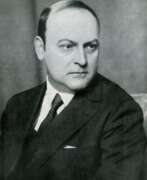

Léon-Paul Fargue was a French poet and novelist, journalist and publicist.
Léon-Paul studied at the Lycée Henry IV in Paris and as a young man became a member of the Symbolist circle associated with Le Mercure de France. His first collection of poems was published in 1912 and reprinted in 1918. After 1930, Fargue practiced journalism almost exclusively, writing newspaper columns and lyrical essays on Parisian life.
Léon Fargue's work encompasses various literary movements, being a kind of bridge from Symbolism to Surrealism. His work has also been associated with the Dadaists and the Cubists, but he followed his own path throughout his life. Fargue was among the founders of the Nouvelle Revue Française in 1912 and participated in the first issue of the surrealist journal Literature in 1919, and was one of the leaders of the experimental journal Commerce in the 1920s. Farg was friends with many writers, artists and composers, including Pablo Picasso and Igor Stravinsky.
In 1937, Léon-Paul Fargue was elected a member of the Académie Mallarmé, and in 1946 he won the Grand Poet Laureate of Paris.


Aleсos Fassianos (Greek: Αλέκος Φασιανός), also Alexandre Fassianos, was a Greek painter, writer and poet. He is internationally known for his figurative paintings that depict the contemporary world in a mythological way.


Robert Filliou is a French postmodern artist and poet, author, director and producer of videos and sculptures, working in the genres of happening and performance art. Filloux was a member of the Fluxus movement and the creator of the concept of the Museum in a Hat.


Pavel Nikolayevich Filonov (Russian: Павел Николаевич Филонов) was a distinguished Russian avant-garde painter, known for his unique approach to art and his profound influence on the culture of painting. Born in 1883, Filonov dedicated his life to developing a method he termed "Analytical Art," aiming to dissect and represent the inner dynamics of the visible world. His commitment to detail and a philosophy that art should be "made by all, for all" set him apart from his contemporaries.
Filonov's work is celebrated for its intricate texture and complex compositions, embodying a meticulous technique that captures the essence of his subjects. Unlike other artists of his time, Filonov refused to sell his artwork, believing it was a collective treasure that should benefit society. This idealism contributed to his relative obscurity during his lifetime, but posthumously, his oeuvre has been recognized for its visionary qualities. Notable works like "The Formula of the Petrograd Proletariat" exhibited at the Russian Museum in Saint Petersburg showcase his mastery and ideological commitment to art.
Filonov's legacy is a testament to his relentless pursuit of an artistic vision that was both revolutionary and deeply humanistic. His works, housed in prestigious museums and galleries, continue to inspire art collectors and experts, offering a window into the radical experiments of early 20th-century Russian art.
For those intrigued by Filonov's unique perspective and contributions to the art world, staying informed about upcoming exhibitions, sales, and auction events is essential. Signing up for updates ensures enthusiasts and collectors alike won't miss an opportunity to engage with the profound and captivating world of Pavel Nikolayevich Filonov.


Ian Hamilton Finlay was a Scottish poet, writer, artist and gardener.
Finlay's work is notable for a number of recurring themes: a penchant for classical writers (especially Virgil); a concern with fishing and the sea; an interest in the French Revolution; and a continual revisiting of World War II and the memento mori Latin phrase Et in Arcadia ego.
Finlay was nominated for the Turner Prize in 1985. He was awarded honorary doctorates from Aberdeen University in 1987, Heriot-Watt University in 1993 and the University of Glasgow in 2001, and an honorary and/or visiting professorship from the University of Dundee in 1999. The French Communist Party presented him with a bust of Saint-Just in 1991. He received the Scottish Horticultural Medal from the Royal Caledonian Horticultural Society in 2002, and the Scottish Arts Council Creative Scotland Award in 2003.


Ernst Fuchs was an Austrian painter, draftsman, printmaker, sculptor, architect, stage designer, composer, poet, and one of the founders of the Vienna School of Fantastic Realism. In 1972, he acquired the derelict Otto Wagner Villa in Hütteldorf, which he restored and transformed. The villa was inaugurated as the Ernst Fuchs Museum in 1988.


Emile Gallé was a French artist and designer who worked in glass, and is considered to be one of the major innovators in the French Art Nouveau movement. He was noted for his designs of Art Nouveau glass art and Art Nouveau furniture, and was a founder of the École de Nancy or Nancy School, a movement of design in the city of Nancy, France.


Emilio Greco was an Italian realist sculptor, draftsman, writer and poet.
At the age of 13, Greco was apprenticed to a mason and later studied at the Academy of Fine Arts in Palermo. His first solo exhibition took place in 1946. Emilio Greco created monumental figurative works in bronze and marble, park sculptures, primarily nude female figures and portraits. His sculptures are characterized by refined, elongated forms in the tradition of Italian mannerism. Notable among them is the monument to the character Pinocchio (Pinocchio and the Fairy) for the town of Collodi.
Greco also designed one of the bronze doors of the cathedral in Orvieto and the monument to Pope John XXIII in St. Peter's Basilica. In 1974, a Greco Garden dedicated to his works was opened at the Open Air Museum in Hakone, Japan.


Elena Genrikhovna Guro (Russian: Еле́на Ге́нриховна Гуро́), born in 1877 in St. Petersburg, Russia, and passing in 1913, was a pioneering figure in the Russian Futurist movement. As a multifaceted artist, she delved into painting, writing, and poetry, marking her as a versatile and innovative force in the early 20th century Russian avant-garde. Guro's work is distinguished by its embrace of Futurism, a movement that sought to break away from traditional art forms and explore dynamic means of expression. Her contributions were not only limited to visual arts but also extended to literature, where she experimented with narrative forms and language, often incorporating nonsensical elements to challenge conventional aesthetics.
Guro's literary works, such as "The Little Camels of the Sky," demonstrate her experimental approach to language and form, embodying the Futurist fascination with the aesthetic possibilities of words. This approach is evident in her poetry and short stories, where she utilized single-word sentences and nonsense words to capture the essence of moments or convey a childlike perspective. Such techniques allowed her to explore the texture of language and its visual and auditory qualities, making her work resonate with the innovations of the Futurist and Dada movements.
Despite her early death at the age of 36, Guro's legacy continues to be celebrated for its contribution to the evolution of Russian modernism. Her work bridged the gap between the Symbolist movement and Futurism, contributing significantly to the dialogue around art and literature in her time. Her husband, Mikhail Matyushin, further propagated her artistic theories, ensuring that her innovative approach to color and form continued to influence Russian art and literature after her passing.
Elena Genrikhovna Guro remains an inspirational figure in the world of art and literature, embodying the spirit of innovation and exploration that defined the early 20th century avant-garde. Her works, which blend poetic language with vivid imagery, invite audiences to reconsider the boundaries between different art forms and the potential of language as an artistic medium.
For those intrigued by the rich tapestry of Russian Futurism and the unique voice of Elena Guro, signing up for updates on her works, sales, and auction events can deepen your appreciation and understanding of this pivotal artist's contributions. This subscription will ensure you stay informed about the latest insights and opportunities related to Elena Genrikhovna Guro's enduring legacy.


Aldona Maria Gustas is a German poet, illustrator, and graphic designer of Lithuanian origin.
In 1972, Gustas co-founded an art forum in West Berlin, the Berliner Malerpoeten, a group of artists who simultaneously wrote and illustrated their works.






























































